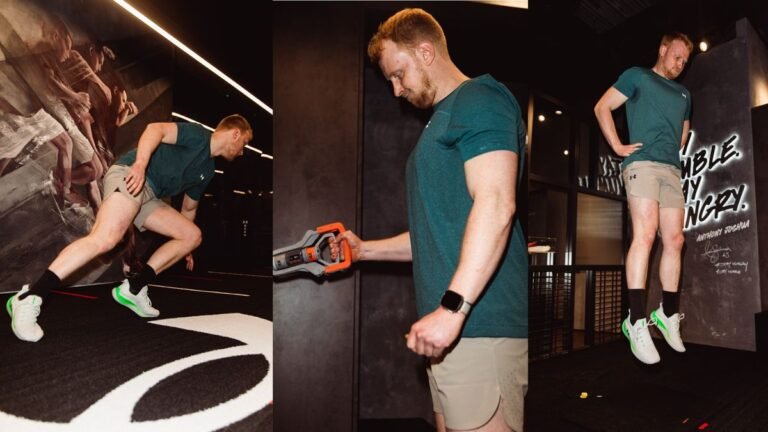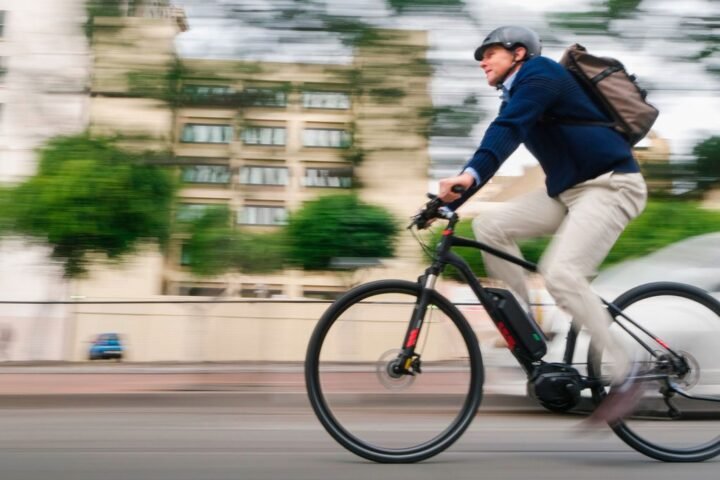I wanted to be a soccer player growing up, as did most people at my English school. I didn’t have the talent—few do—but some of those who have the requisite natural gifts still fly under the radar.
That’s why the Under Armour Next Academy was created—to identify sports stars of the future with six simple athletic tests, open to all-comers aged between 16 and 20. And as a one-time aspiring athlete, I couldn’t resist giving them a go.
My only expectation going in was that I would have a good time. But the tests actually revealed some weaknesses which have helped inform my training going forward.
What Is The Under Armour Next Academy?
The Under Armour Next Academy has been set up inside London’s Battersea Power Station, and assesses endurance, strength, speed, agility, power and athletic intelligence through six separate tests.
Anyone aged 16-20 can apply online to take the tests for free, with top performers earning the chance to compete for one of 12 year-long Under Armour sponsorships.
Under Armour Next Academy Fitness Tests
Athletic Intelligence Test
Many of the Under Armour Next Academy tests are ones you can try at home. This first one, not so much.
I was faced with a wide panel containing thousands of LED lights. Green squares would flash up in front of me, turn red after a second or two then explode—my mission was to diffuse them with a simple tap, but it was harder than it sounded.
After three goes, I’d hit a high score of 80, which I was fairly happy with.
“Not to make you feel bad, but there’s one guy who came in and hit about 280,” the trainers taking me through the tests told me. I was just below average too—86 for males and 94 for females.
Strength Test
After hanging up my soccer cleats, I turned to CrossFit to satisfy my competitive streak. As a result, I thought the strength test might be right up my alley, but it wound up being my worst score.
With my biceps by my side and my elbow at a right angle, I had to squeeze a grip dynamometer machine as hard as I could for a couple of seconds.
I tapped out just over 50kg—a little over half what a teenage aspiring American football player had hit recently, according to the Academy team. It was also slightly below the male average of 53kg.
I already knew grip strength isn’t a strength for me, but up to this point I’ve never given it the time of day in my training. Thankfully, there are plenty of ways to improve your grip strength.
Power Test
When I think of a powerful athlete, my mind turns to World’s Strongest Man competitors shifting huge weights. What I often forget to consider is the speed element—power equals force times velocity, after all.
That’s why the Academy’s power test is a max vertical jump, and it’s as straightforward as it sounds. From a standing start, jump as high as you can. The only conditions are that your hands have to stay on your hips and your legs must stay straight during the jump.
The Under Armour team had a digital sensor to measure scores. You’re not going to find this at your average gym, but you could replicate it by jumping next to a wall while a partner marks the height your feet reach.
Going in, I was told that anything over 50cm was good, average for men was 43cm and average for women was 33cm. I managed 45cm.
Apparently the record holder on this test was a teen, not much taller than five foot, who blitzed the competition with a jump nearly double mine.
Speed Test
The speed test is a 15m sprint, with the Under Armour Next Academy’s sensors on hand to give me my time to a fraction of a second.
I had been expecting this and after giving my hamstrings a very thorough warm-up I was excited to give it a try.
The trainers on hand set a goal of 2.5 seconds and my initial attempts sat just below this at between 2.3 and 2.4 seconds.
I was satisfied with that, with the average male and female times sitting at 2.42 and 2.7 seconds respectively. Then one freak score around the 2.2 second mark, which I’m choosing not to question, gave me my best result of the assessment as a whole.
Agility Test
The 5-10-5 drill tests agility by challenging you to move fast through a couple of changes of direction.
When I did it, there were three parallel lines each five yards apart—you can mark these distances out with cones if you’re doing it elsewhere.
Start by standing at the middle line, facing along it, then turn 90° and sprint to one of the lines on either side of you. Touch your foot on the line, make an about turn, then sprint to the line furthest from you.
Again, touch it with one foot as you turn back on yourself, then hare back to the central line to finish.
This was the test where my former soccer obsession really came to the fore, and while I failed to note my exact time I know I managed to beat the averages of 4.95 and 5.4 seconds for male and female participants.
Endurance Test
Whether you call it the bleep test, the multi-stage fitness test or hell on earth, chances are you’re familiar with this shuttle run test.
Under Armour uses a variation. Start running on beep one, make it to a 15m marker before beep two, turn and return to the start point ahead of beep three, then rest for 10 seconds before going again.
The interval between the beeps gets shorter as you progress through the levels. “Level 17 is good, level 19 is really good,” the trainers tell me.
There’s a reason they leave this one till last. It feels like a walk in the park at first, but it quickly ramps up.
I hit a wall at level 18, with my legs turning to lead and refusing to cooperate as I urged them to move faster.
What I Learned
After the last test, the Under Armour Next Academy team issued me with a scorecard showing my results. Rather than giving me my times and figures, it showed a score out of 100 for each one, as well as an overall result: 62.56.
The trainers then showed me the leaderboard, with top performers achieving 80 and above. No late Paris 2024 push for me, then.
But I did really enjoy myself. I’ve also been able to change my training since to address my weaknesses in strength, grip and power.
I’m hoping my tweaked take on the 5×5 workout, plenty of loaded carries and a healthy dose of contrast training should do the trick.







